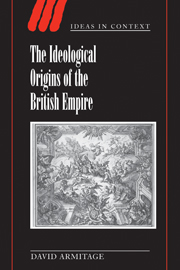Book contents
- Frontmatter
- Contents
- Acknowledgements
- 1 Introduction: state and empire in British history
- 2 The empire of Great Britain: England, Scotland and Ireland c. 1542–1612
- 3 Protestantismand empire: Hakluyt, Purchas and property
- 4 The empire of the seas, 1576–1689
- 5 Liberty and empire
- 6 The political economy of empire
- 7 Empire and ideology in the Walpolean era
- Bibliography
- Index
- Ideas in context
7 - Empire and ideology in the Walpolean era
Published online by Cambridge University Press: 06 July 2010
- Frontmatter
- Contents
- Acknowledgements
- 1 Introduction: state and empire in British history
- 2 The empire of Great Britain: England, Scotland and Ireland c. 1542–1612
- 3 Protestantismand empire: Hakluyt, Purchas and property
- 4 The empire of the seas, 1576–1689
- 5 Liberty and empire
- 6 The political economy of empire
- 7 Empire and ideology in the Walpolean era
- Bibliography
- Index
- Ideas in context
Summary
When Britain first, at heaven's command,
Arose from out the azure main,
This was the charter of the land,
And guardian angels sung this strain –
‘Rule, Britannia, rule the waves;
Britons never will be slaves’.
It is now an historiographical commonplace that the 1730s and early 1740s marked a watershed in the history of the British state and empire. Both British and American historians take the decade on either side of 1740 as a pivotal moment in the histories of nationalism, patriotism and national identity. They do so because this seems to be the moment at which British identity began to coalesce within Britain itself, a generation after the Anglo-Scottish Union of 1707, to mark ‘the birth of a powerfully self-confident British nationalism’. ‘It was precisely during these early conflicts in the formation of British markets that the symbols ofthe British nation came into being’: the Union flag, ‘God Save the King’, ‘Rule, Britannia’, the rules of cricket and Edmund Hoyle's codification of whist, quadrille, backgammon and chess. At the same time, it has been argued, 1740 marked the end of the period – roughly corresponding to the length of a single lifetime – in which communications around the British Atlantic world had changed substantially and irreversibly. From this point onward, a British Atlantic community became conceivable in practice as ‘colonial leaders initiated changes in the meaning of the word “empire” to include themselves and their localities in an organic union with the British Isles in what, by 1740, was coming to be called the “British Empire”’.
- Type
- Chapter
- Information
- The Ideological Origins of the British Empire , pp. 170 - 198Publisher: Cambridge University PressPrint publication year: 2000



